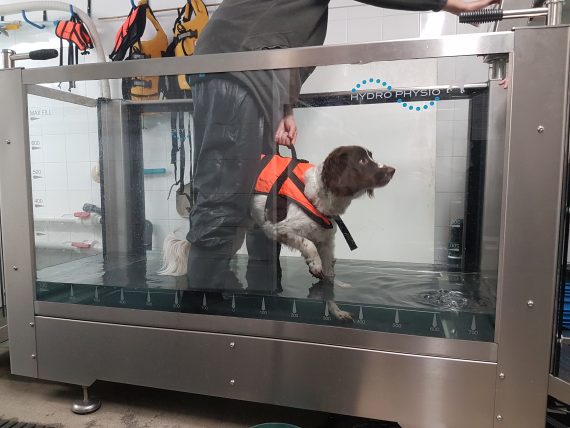Introducing our Hydro Physio Canine Treadmill

Here at WitsEnd, we are proud and excited to have a Hydro Physio machine and are now able to use water treadmill exercises as part of a physiotherapy rehabilitation programme, offering many benefits for your dog.
Here we explain what the Hydro Physio machine is and how it can aid your pet’s recovery along with their general health.
What is the Hydro Physio Machine?
Hydro Physio is the name of the leading range of canine hydrotherapy treadmills that uses heated sanitised water and has been developed with the help of vets and rehabilitation specialists to create an amazing product that is extremely effective. The walkthrough, transparent design allows the therapist and the owner to see how the dog is using each of its limbs in the water. The water depth and temperature can easily be adjusted making the dog using the machine as comfortable as possible. The side platforms also mean your dog can be supervised by the specialist, helping them feel at ease throughout the entire process.
When should the water treadmill be used?
The great advantage about this treatment is the large array of conditions it can help with including for example:
• Post operation recovery, e.g. fractures, spinal surgery, hip replacements, cruciate and patella repairs
• Recovery from soft tissue injuries, e.g. tendon problems, ligament strains and muscle injuries
• Orthopaedic conditions e.g. hip and elbow dysplasia
• Arthritis
• Nerve damage
• Obesity
What are the benefits of the underwater treadmill?
• By varying the water level, the amount of work that the dog does can be altered from light to more strenuous exercise.
• Improves balance and stability
• Improves posture and your dog’s walking action.
• The warm water helps relieve pain and stiffness
• Helps aid joint mobilisation
• Builds up muscle strength
• Improves cardiovascular fitness
• Promotes muscle relaxation
• Improves circulation
• Encourages weight loss & improves general health
• The speed of the treadmill can be adjusted, enabling the treatment to be tailored to suit each dog. If your dog has shorter legs, the treadmill can go at a slower pace to accommodate this. The speed of the treadmill can also be varied to encourage usage of limbs.
When should it not be used?
Although water therapy can be very beneficial for your dog, there are some circumstances where it may not be the best option. This includes dogs that have respiratory or cardiac disease.
Next steps
As with any form of treatment, water therapy will take time to work and the aim is to slowly build up your dog’s strength. Many signs of pain will decrease over time if the treatment is used on a regular basis.
Water therapy is most effective when used in conjunction with a physiotherapy rehabilitation programme. Following most injuries and surgery your dog may have muscle loss and/or may be compensating by placing more weight on the other limbs. This can cause tension in the muscles, ligaments, and tendons and relaxation of these tissues through physiotherapy techniques such as massage and stretching before and after the treadmill will reduce any risk of aggravating weakened tissues.
It is normal for your pet to feel initially apprehensive when they are introduced to water therapy, but over time they should become familiar with the equipment and process, and enjoy the therapeutic benefits of the treatment.
Always discuss with a qualified vet or specialist about water treadmill as a treatment option for your dog.
Our team of specialists is led by Dr Shahad Mohammed (PhD), who is qualified in Veterinary Physiotherapy. Shahad oversees all the rehabilitation work done here at WitsEnd including hydrotherapy and undertakes any veterinary/ physiotherapy liaison to ensure that your dog’s individual programme is appropriately tailored to their recovery and development needs.
If you think your dog can benefit the use of our treadmill, please do get in touch with one of our team on 0116 244 2455 or email us at [email protected] to find out more information. We’ll be more than happy to discuss any questions that you might have and to recommend the best course of action for you and your dog.